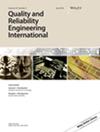使用 WOA-XGBoost 代用模型对考虑了多源不确定性的叶轮进行疲劳可靠性评估
IF 2.8
3区 工程技术
Q3 ENGINEERING, INDUSTRIAL
引用次数: 0
摘要
在使用蒙特卡罗模拟(包括重复有限元分析)对叶轮进行疲劳可靠性评估时,应考虑各种不确定性,以确保疲劳预测的全面性。这些不确定性包括来自几何、材料和负载条件的已知不确定性,以及来自失效物理(PoF)模型参数的已知不确定性,从而得出疲劳预测结果。然而,在疲劳可靠性分析中,后一种不确定性往往被忽视。而当涉及许多随机变量时,由于需要进行大量的有限元分析,可靠性评估在计算上将变得难以承受且效率低下。为解决这一问题,我们基于使用拉丁超立方采样(LHS)获得的相对较少的有限元分析结果,开发了鲸鱼优化算法-极端梯度提升(WOA-XGBoost)替代模型。其优势在于设计变量的可解释性和微调超参数的有效确定。考虑到 11 个输入变量的不确定性,对叶轮进行了案例研究,利用 400 个实际有限元分析样本建立了一个高效的 XGBoost 模型,其测试集 R2 大于 0.93。此外,重要性分析表明,弹性模量和密度对最大应变的影响最大,两者的重要性之和达到 82.3%。此外,与 Seeger 方法相比,中值法得出的疲劳参数下的可靠性评估结果趋于保守。本文章由计算机程序翻译,如有差异,请以英文原文为准。
Fatigue reliability evaluation for impellers with consideration of multi‐source uncertainties using a WOA‐XGBoost surrogate model
When using Monte Carlo simulation involving repeated finite element analysis (FEA) to perform fatigue reliability evaluation for an impeller, a variety of uncertainties should be considered to ensure the comprehensiveness of fatigue predictions. These uncertainties include the aleatory uncertainty from the geometric, material and load condition, and epistemic uncertainty from the parameters of the physics‐of‐failure (PoF) model to yield fatigue prediction. However, the latter uncertainty is often ignored in fatigue reliability analysis. And the reliability assessment will become computationally unaffordable and inefficient when there are many random variables involved, as an enormous amount of FEAs are demanded. To address this problem, a Whale Optimization Algorithm‐extreme gradient boosting (WOA‐XGBoost) surrogate model is developed, based on relatively few FEA results obtained using a Latin hypercube sampling (LHS). Its strengths lie in the interpretability of the design variables and effective determination of fine‐tuned hyperparameters. A case study on an impeller is conducted considering uncertainties from 11 input variables, where an efficient XGBoost model with an R 2 greater than 0.93 on test set is established using 400 samples from practical FEAs. In addition, the importance analysis indicates that elasticity modulus and density play the greatest impact on the maximum strain, showing a combined importance of 82.3%. Furthermore, the reliability assessment results under fatigue parameter derived from the Median method tend to be more conservative compared to those obtained from the Seeger method.
求助全文
通过发布文献求助,成功后即可免费获取论文全文。
去求助
来源期刊
CiteScore
4.90
自引率
21.70%
发文量
181
审稿时长
6 months
期刊介绍:
Quality and Reliability Engineering International is a journal devoted to practical engineering aspects of quality and reliability. A refereed technical journal published eight times per year, it covers the development and practical application of existing theoretical methods, research and industrial practices. Articles in the journal will be concerned with case studies, tutorial-type reviews and also with applications of new or well-known theory to the solution of actual quality and reliability problems in engineering.
Papers describing the use of mathematical and statistical tools to solve real life industrial problems are encouraged, provided that the emphasis is placed on practical applications and demonstrated case studies.
The scope of the journal is intended to include components, physics of failure, equipment and systems from the fields of electronic, electrical, mechanical and systems engineering. The areas of communications, aerospace, automotive, railways, shipboard equipment, control engineering and consumer products are all covered by the journal.
Quality and reliability of hardware as well as software are covered. Papers on software engineering and its impact on product quality and reliability are encouraged. The journal will also cover the management of quality and reliability in the engineering industry.
Special issues on a variety of key topics are published every year and contribute to the enhancement of Quality and Reliability Engineering International as a major reference in its field.

 求助内容:
求助内容: 应助结果提醒方式:
应助结果提醒方式:


